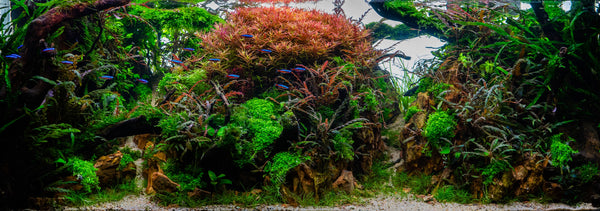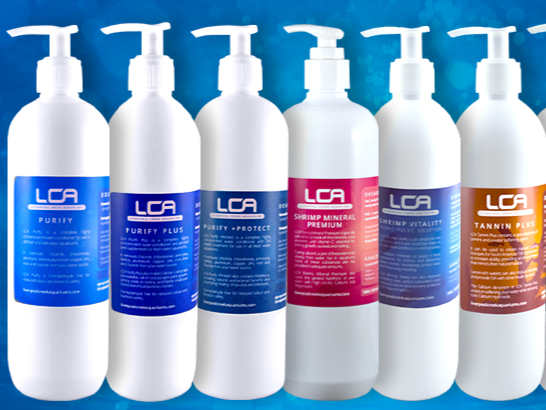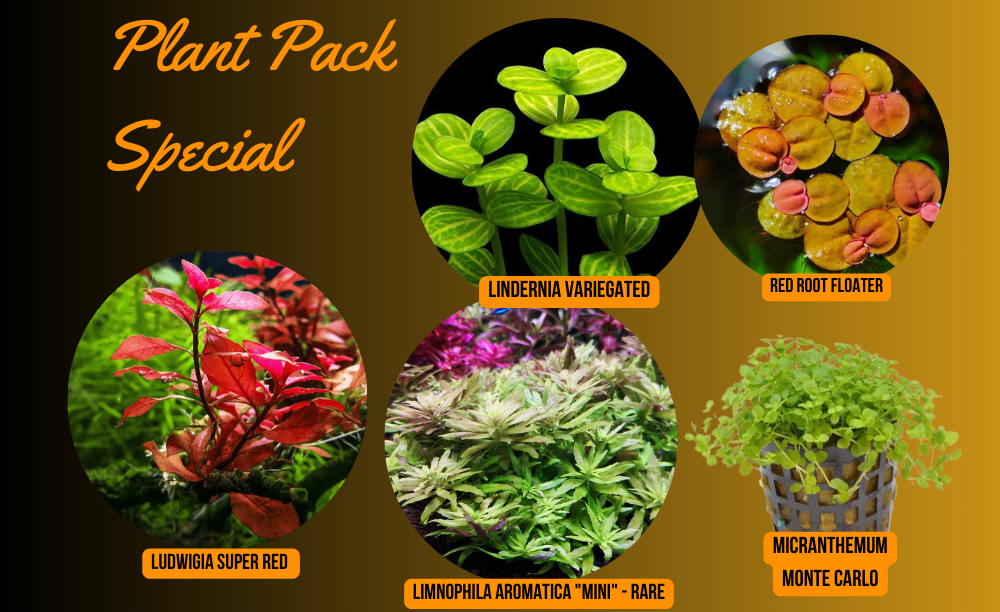Your Cart is Empty
we are now CLOSED FOR OUR ANNUAL BREAK
ANY NEW ORDERS WILL NOT BE SENT UNTIL EARLY JANUARY
***FREE SHIPPING ON ORDERS OVER $200***
we are now CLOSED FOR OUR ANNUAL BREAK
ANY NEW ORDERS WILL NOT BE SENT UNTIL EARLY JANUARY
***FREE SHIPPING ON ORDERS OVER $200***
Store

Ideal Temperature
3 min read
Ideal Temperature in Planted Tanks
If you’re keeping a planted aquarium, you know your plants need a stable amount of light, nutrients and CO2 to really thrive. So what do you do when all of these parameters are perfect, but your plants are not looking their best?
There’s one other variable to consider that is often overlooked, and that’s temperature!
Temperature in Nature
Many popular aquarium plants come from tropical areas, so you would think they would also prefer these warm conditions in the home aquarium. A lot of aquariums are kept at these warmer temperatures, around 25-26 degrees, which most plants will happily grow in provided ideal conditions are met (stable light, nutrients and CO2).
However, in their natural habitats, popular aquarium plants don’t have these stable temperatures and conditions to enjoy. Most are found growing in the shallows at the edges of streams, ponds and lakes, where water levels and temperatures change with the season.
In reality, these plants can be grown in temperatures as low as 20 degrees and fluctuations in temperature will not be harmful as long as they are gradual. Plants will survive short term in temperatures lower than 20 degrees but growth rate and form will likely be affected.
Temperature in the Aquarium
Temperature will help determine the rate of a plant’s metabolism in your aquarium. Basically, the warmer the temperature, the faster your plants will photosynthesise and grow.
In aquariums where the temperature is set above 26 degrees, plants are going to be metabolising rapidly and will therefore have a greater need for nutrients. If they appear to be struggling, you might need to increase the amount of CO2 and fertiliser you are adding. This is especially true of CO2, as gas solubility decreases as water temperature rises, affecting the saturation of oxygen and CO2.
On a similar note, if your temperature is in a low 20-22 degree range, plants will be metabolising at a much slower rate and won’t require as much feeding.
It’s important to note that your temperatures can get too warm for plants. If temperatures exceed 27 degrees for extended periods of time, plants that prefer cooler temperatures (e.g. buce, moss, tiger lotus) will do very poorly and can potentially die. More sensitive plant species such as Eriocaulons will also stunt or melt in these temperatures. Warmer water also encourages algae such as GDA (Green Dust Algae) to form.
Conversely, temperatures can also be too cold, causing plant metabolism to all but stop. This will lead to stunting and other growth issues, with the potential for other algae to appear as nutrients are not being used by your plants.
The ideal temperature for planted aquariums seems to be between 22 and 26 degrees. This range allows for healthy metabolic rates in plants and for most fish/livestock species to live comfortably. CO2 is more readily dissolved and available for longer. Plants grown in these temperatures will generally grow with shorter internodes between leaves and with a more compact, bushy form, with good colouration due to healthy photosynthesis rates. Warmer temperatures will typically lead to “leggy” growth.
Maintaining Ideal Temperatures
Living in Australia can make it difficult to maintain stable temperatures in the ideal range of aquarium plants, especially in the warmer months.
There are a few easy tricks to keep water temperatures lower during the hotter months:
From The LCA Team
Every Solution For Your Aquarium
There’s one other variable to consider that is often overlooked, and that’s temperature!
Temperature in Nature
Many popular aquarium plants come from tropical areas, so you would think they would also prefer these warm conditions in the home aquarium. A lot of aquariums are kept at these warmer temperatures, around 25-26 degrees, which most plants will happily grow in provided ideal conditions are met (stable light, nutrients and CO2).
However, in their natural habitats, popular aquarium plants don’t have these stable temperatures and conditions to enjoy. Most are found growing in the shallows at the edges of streams, ponds and lakes, where water levels and temperatures change with the season.
In reality, these plants can be grown in temperatures as low as 20 degrees and fluctuations in temperature will not be harmful as long as they are gradual. Plants will survive short term in temperatures lower than 20 degrees but growth rate and form will likely be affected.
Temperature in the Aquarium
Temperature will help determine the rate of a plant’s metabolism in your aquarium. Basically, the warmer the temperature, the faster your plants will photosynthesise and grow.
In aquariums where the temperature is set above 26 degrees, plants are going to be metabolising rapidly and will therefore have a greater need for nutrients. If they appear to be struggling, you might need to increase the amount of CO2 and fertiliser you are adding. This is especially true of CO2, as gas solubility decreases as water temperature rises, affecting the saturation of oxygen and CO2.
On a similar note, if your temperature is in a low 20-22 degree range, plants will be metabolising at a much slower rate and won’t require as much feeding.
It’s important to note that your temperatures can get too warm for plants. If temperatures exceed 27 degrees for extended periods of time, plants that prefer cooler temperatures (e.g. buce, moss, tiger lotus) will do very poorly and can potentially die. More sensitive plant species such as Eriocaulons will also stunt or melt in these temperatures. Warmer water also encourages algae such as GDA (Green Dust Algae) to form.
Conversely, temperatures can also be too cold, causing plant metabolism to all but stop. This will lead to stunting and other growth issues, with the potential for other algae to appear as nutrients are not being used by your plants.
The ideal temperature for planted aquariums seems to be between 22 and 26 degrees. This range allows for healthy metabolic rates in plants and for most fish/livestock species to live comfortably. CO2 is more readily dissolved and available for longer. Plants grown in these temperatures will generally grow with shorter internodes between leaves and with a more compact, bushy form, with good colouration due to healthy photosynthesis rates. Warmer temperatures will typically lead to “leggy” growth.
Maintaining Ideal Temperatures
Living in Australia can make it difficult to maintain stable temperatures in the ideal range of aquarium plants, especially in the warmer months.
There are a few easy tricks to keep water temperatures lower during the hotter months:
- Air conditioning – They’re costly to run 24/7 but will easily provide stable temperatures. You can also combine air conditioning with a fan pointed at your aquarium to reduce the temperature lower than the setting on your A/C.
- Fans – Purpose-built fans that hang on the rim of your aquarium, ceiling fans, or a simple pedestal fan pointed at the water’s surface will all do a great job of reducing the temperature on warm days, and they’re cheap to run. The only downside is that unlike A/C they can only reduce temperatures to a certain point.
- Frozen bottles – On very hot days, where A/C is not an option, utilising fans and a frozen water bottle placed in your aquarium is great to reduce temperatures, especially in emergencies where water temperatures are rising above 30 degrees.
- Aquarium chiller – Expensive to buy and run, but the most consistent and convenient method next to air conditioning. If you live in an area that regularly gets very hot days, this might be your best choice.
- Lighting – If you’re using older metal halide or T5 lighting, consider upgrading to an LED system that won’t radiate as much heat.
- Curtains/blinds – A simple enough idea, reduce the amount of sunlight entering the room and temperatures will also be reduced.
From The LCA Team
Every Solution For Your Aquarium
Subscribe
Sign up to get the latest on sales, new releases and more …

Join Us
Join our Facebook group and benefit from the knowledge of
Australia’s largest community of planted aquarium enthusiasts!







